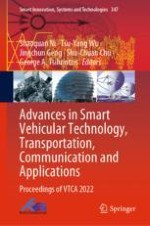This book includes selected papers from the fifth International Conference on Smart Vehicular Technology, Transportation, Communication and Applications (VTCA 2022), held in online mode during December 24–26, 2022. The book includes research works from engineers, researchers, and practitioners interested in the advances and applications in the field of vehicle technology and communication. The book covers four tracks, namely (1) vehicular networking security, (2) vehicular electronics, (3) intelligent transportation systems and applications, and (4) smart vehicular communication networks and telematics.
